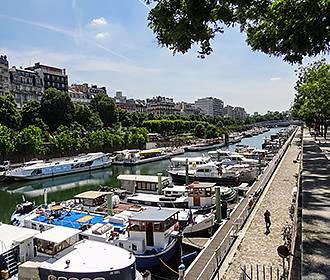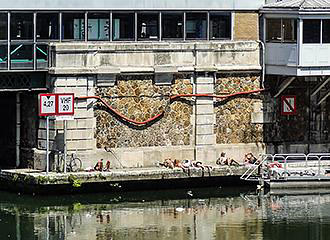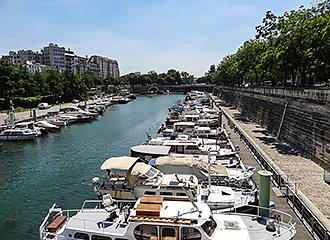Canal Saint-Martin in Paris
The construction of the Canal Saint-Martin was ordered during the reign of Napoleon Bonaparte and links to the Canal de l’Ourcq, and today it is used mainly by pleasure craft for excursions, plus has a marina called the Port de l’Arsenal.
A bit of history
It was Napoleon Bonaparte that first gave the orders for a canal to be constructed within the city of Paris in order to provide a link from the River Seine and the Port de l’Arsenal to the Bassin de la Villette and the Canal de l’Ourcq for the shipping of food, other goods and materials.
Work started at both ends of the Canal Saint-Martin in 1805, however, because of the urbanisation of the area, there were many technical challenges they had to overcome, which is why it took until 1825 to complete, and this project was funded through a new tax that they had introduced on wine.
Now the length of the Canal Saint-Martin is around 4.5km with a total of nine locks, however, during the Second Empire when Baron Haussmann was reorganising much of Paris, there were warehouses and mills created along with several additional roads, and the idea of a moveable bridge over the canal was discussed.
Yet the engineer Belgrand came up with a solution, which involved moving one of the locks far further upstream, and this allowed for the water level to be lowered so that a normal bridge could be put in place.
But work and alterations did not stop there, and from 1860 to 1862 a vaulted tunnel was constructed, which enclosed the canal from the Bastille and the Place de la Bastille up to the Avenue de la Republique, and a new road was made above, called the Boulevard Richard-Lenoir.
It was then in 1906 that the next major changes took place, with an additional section of the Canal Saint-Martin being enclosed, and known as The Temple, this led to another road being put in place above the canal, which is called the Boulevard Jules-Ferry.
About the Canal Saint-Martin in Paris
Much of Paris has changed over the years, and the Canal Saint-Martin is definitely no exception, and although it was originally designed for goods including food and raw materials, today it is mainly used by pleasure craft and sightseeing boat tours in Paris, like the company Canauxrama.
This particular canal is also very popular for people taking a stroll, cycling, rollerblading, and sightseeing with some old bridges in Paris dating from the 19th century, plus there is a garden called the Jardin du Port de l’Arsenal located by the marina, which is a great place to relax and is also popular with students.
Visiting the Canal Saint-Martin
The Canal Saint-Martin goes from the River Seine, which is where you will find the Metro station called the Quai de la Rapee stop serving line 5, and goes up passed the Pont Morland and the Bassin de l’Arsenal, or Port de l’Arsenal, all above ground up to just before the Place de la Bastille, which is where you will find the Bastille Metro stop serving lines 1, 5 and 8.
The Canal Saint-Martin is then in a tunnel until you reach the Palais des Glaces, which is one of the theatres in Paris, then it goes above ground again apart from one small section as it continues passed Bizz'art towards the next Metro stop called Jaures, which is by the Place de la Bataille de Stalingrad and serves Lines 2, 5 and 7B.
From there it is a very short distance to the Bassin de la Villette where it then connects via a double lock to Canal de l'Ourcq, which then continues through Parc de la Villette where you can discover numerous tourist attractions such as the Cite des Sciences et de l'Industrie, Geode and the Cite de la Musique with its fabulous Music museum.


